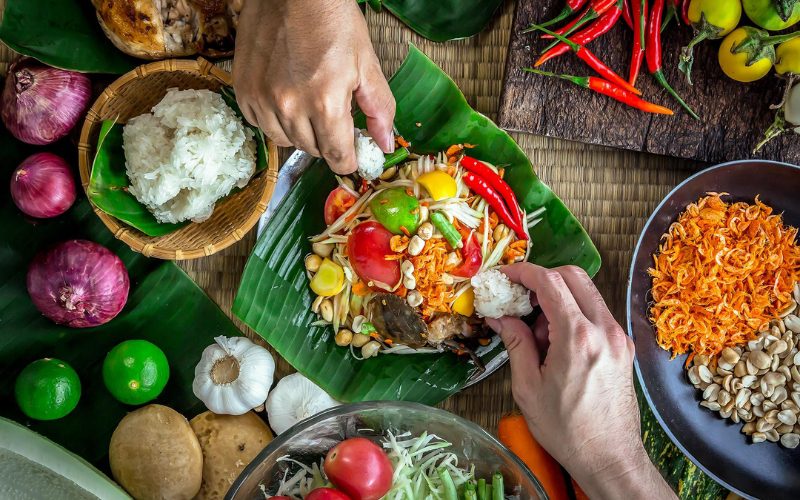
Laos food is strongly impacted by Chinese, Thai, and French culture. However, it has its claim contrasts in different regards. There are large quantities of fresh, herbs and vegetables in Laos meals. Tasting Laos dishes, you will realize that it is not merely sweet and sour but even bitter. It is also worth noting that Laos food is often served at room temperature. It could be explained that many Laos foods are served with sticky rice and traditionally eaten by hand. Here are the top 15 Laos dishes you must try.
Why is Laos Food so Special?
Lao cuisine is a captivating culinary experience. Its foundation – sticky rice is not merely a staple but a cultural cornerstone, perfectly complementing the dishes’ “intricate flavors”. Lao food is a harmonious blend of sweet, sour, salty, and spicy, creating a complex taste profile. Fresh, local ingredients, particularly abundant herbs and spices, infuse each dish with depth. From the fiery larb to the refreshing tam mak hung, Lao cuisine boasts unique flavors that set it apart. Beyond taste, sharing meals is a cornerstone of Lao culture, making food a central part of the country’s heritage.
Top 15 Laos Food You Must Try
Khao Niao (Sticky Rice)
Khao Niao or sticky rice, is an indispensable component of Lao cuisine. Traditionally, khao niao is steamed in a bamboo steamer, resulting in a soft, chewy consistency. It serves as the perfect vessel for absorbing the rich flavors of various Lao dishes. While often enjoyed with savory accompaniments like grilled meats, laap (spicy minced meat salad), or multiple dips, khao niao also takes center in sweet treats.
The preparation of khao niao is a meticulous process. The rice is soaked in water for several hours before steaming to ensure even cooking. The resulting products are then typically served in a woven bamboo basket, adding to the authentic dining experience.
It is important to note that while khao niao is a filling food, it is often considered a base for other dishes rather than a meal on its own. It is usually accompanied by various meats, salads, soups, or dips.

Khao Niao (Sticky Rice)
Laap/Larp (Chopped meat mixed with fish sauce and herbs)
Laap, a quintessential Lao dish, is a tantalizing blend of flavors and textures. This spicy minced meat salad is a culinary masterpiece that showcases the country’s vibrant food culture.
This Laos food is made with meat like beef, pork, or chicken, modern variations extend to fish and even vegetarian options. Essential ingredients include lime juice for tanginess, fish sauce for umami, chili peppers for heat, and fresh herbs for aroma. The meat is finely chopped and mixed with these components until it changes color and the flavors meld together. Sticky rice powder is added to thicken the mixture. Laap is not just a dish, it is a sensory experience, best enjoyed with sticky rice balancing the intensity of its flavors.
Since it can be a refreshing appetizer, a hearty main course, or even a late-night snack, laap is a versatile dish enjoyed at any time of day in Laos. Its bold flavors and satisfying texture make it a popular choice for casual gatherings, special occasions, or simply a quick and delicious meal. Whether you prefer it spicy or mild, there is a laap to suit every palate.
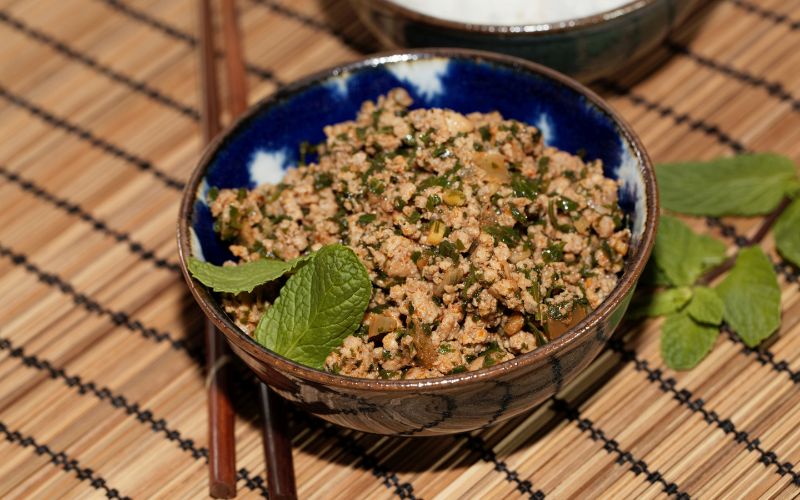
Laap (Chopped meat mixed with fish sauce and herbs)
Mok Pa (Lao Steamed Fish)
Mok Pa is a delightful Lao dish featuring steamed fish wrapped in banana leaves. This aromatic and flavorful creation combines fresh fish with a harmonious blend of herbs, including lemongrass, kaffir lime leaves, and chili. The banana leaf imparts a subtle sweetness while cooking in the fish’s natural juices.
Mekong River fish is used as the main ingredient in this cuisine but other mild-flavored fish can also be substituted. The steaming process locks in the fish’s natural juices, creating a tender and flavorful experience.
Mok Pa is often enjoyed as a main course, paired with sticky rice for a complete and satisfying meal. The delicate flavors and fragrant aroma make it a popular choice for both casual and special occasions, showcasing the best of Lao cuisine’s emphasis on fresh ingredients and subtle flavors.
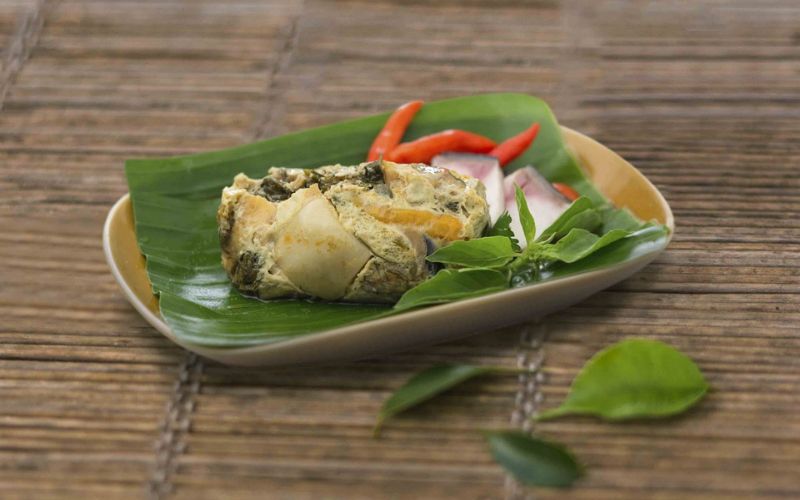
Mok Pa (Lao Steamed Fish)
Tam Mak Houng (Laos Green Papaya Salad)
Tam Mak Houng often referred to as Lao papaya salad, is a vibrant and refreshing dish that encapsulates the essence of Lao cuisine. This spicy and sour salad is a delightful combination of unripe papaya, shredded carrots, green beans, and tomatoes. Key to its distinctive flavor profile is the perfect balance of sweet, sour, salty, and spicy components. The unripe papaya provides a crisp texture, while the addition of lime juice, fish sauce, and chili peppers creates a complex and invigorating taste. Fresh herbs like mint and cilantro elevate the dish with their aromatic qualities. Topped with roasted peanuts for crunch and a touch of sweetness, Tam Mak Houng is a beloved staple in Lao households and a must-try for food enthusiasts exploring the rich tapestry of Southeast Asian flavors.
Tam Mak Houng is a versatile dish enjoyed at various times of the day in Laos. Its refreshing and zesty flavors make it a perfect light lunch, a stimulating appetizer, a quick and satisfying snack, or a delightful side dish to complement grilled meats or sticky rice.
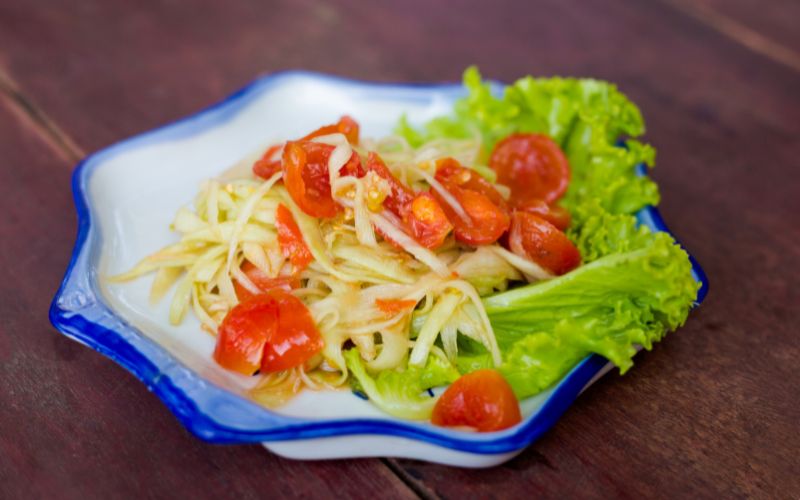
Tam Mak Houng (Laos Green Papaya Salad)
Khao Jii Paté (Lao-style Baguette)
Khao Jii Paté is a beloved Laotian sandwich that reflects the country’s unique culinary blend of traditional flavors and French colonial influences. A testament to the harmonious fusion of cultures, this sandwich is a staple in Laotian cuisine.
The crusty baguette, a French import, provides the perfect foundation for a delightful array of fillings. Typically, the bread is generously stuffed with a paté, often homemade, and featuring a combination of pork and liver. To balance the richness, fresh vegetables like cucumber, pickled carrots, and cilantro are added. The sandwich is then drizzled with a sweet and spicy chili sauce, creating a complex and satisfying flavor profile. Khao Jii Paté is a versatile meal enjoyed by locals and tourists alike, offering a convenient and delicious way to experience Laotian flavors.

Khao Jii Paté (Lao-style Baguette)
Nam Khao (Crisp rice salad)
Nam Khao, a beloved Lap appetizer, is a delightful explosion of textures and flavors. This crispy rice salad originates from Tha Deua, a small port village in Vientiane. The dish features crunchy fried rice balls coated in a tantalizing blend of som moo (fermented pork), peanut, coconut, scallion, fresh herbs like mint and cilantro, and a perfect balance of lime juice and fish sauce.
Nam Khao is a symphony of contrast, with the crispiness of the rice ball complementing the soft texture of the herbs and the bold flavors of the dressing. It is a refreshing and addictive dish that perfectly captures the essence of Lao cuisine.
This cuisine could be served at various times of the day. Its delightful combination of crispy rice, savory flavors, and refreshing elements makes it suitable for light snacks, appetizers, social gatherings, or as a complement to other dishes.
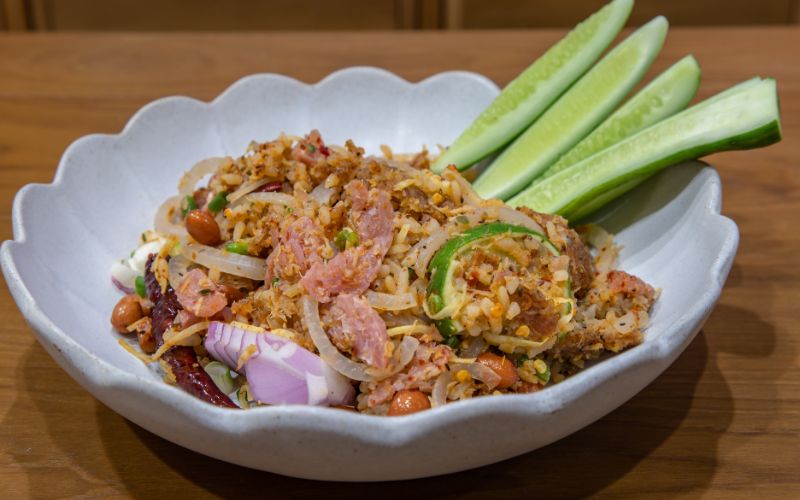
Nam Khao (Crisp Rice Salad)
Kaipen (Fried Seaweed)
Kaipen is a unique Laotian snack crafted from freshwater green algae. Hailing from northern Laos, particularly Luang Prabang, this delicacy is a testament to the region’s ingenuity and resourcefulness.
The process of making kaipen involves harvesting the algae during the dry season, cleaning, and drying it into thin sheets. These sheets are often infused with flavors like garlic, sesame seeds, and sometimes vegetables. The result is a crispy, savory snack reminiscent of seaweed but with a distinctive Laotian character. Kaipen is not only delicious but also packed with vitamins and minerals, making it a healthy treat. Whether enjoyed on its own or as a component in other dishes, kaipen is a must-try for food enthusiasts exploring the culinary treasures of Laos.
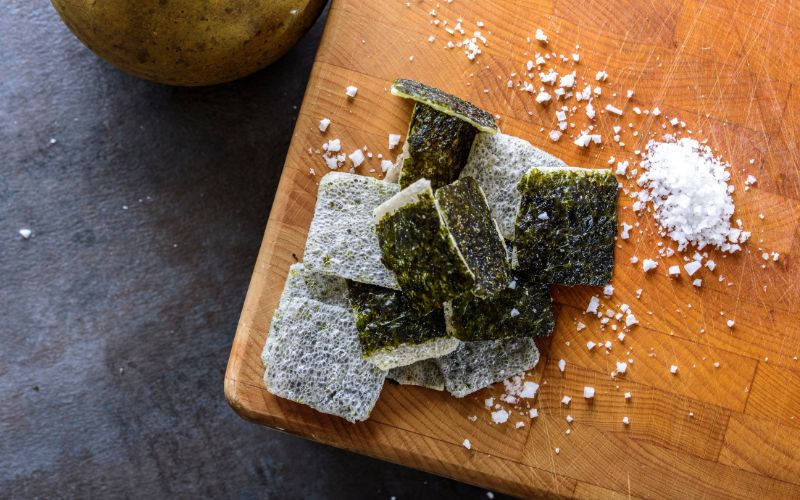
Kaipen (Fried Seaweed)
Khao Soi (Flat Rice Noodle)
Khao Soi is a rich and flavorful Northern Thai curry noodle soup that has gained popularity in Laos. This creamy and aromatic dish features egg noodles bathed in a coconut milk-based curry broth, often infused with the complex flavors of star anise, cardamom, and cinnamon. Tender pieces of chicken or beef are typically added, along with picked mustard greens for a tangy contrast.
Khao Soi is a satisfying meal that combines the conforming warmth of a curry with the satisfying texture of noodles. Often served with crispy noodles on top, which add a delightful crunch, this dish is a culinary delight that showcases the unique flavors of the region.
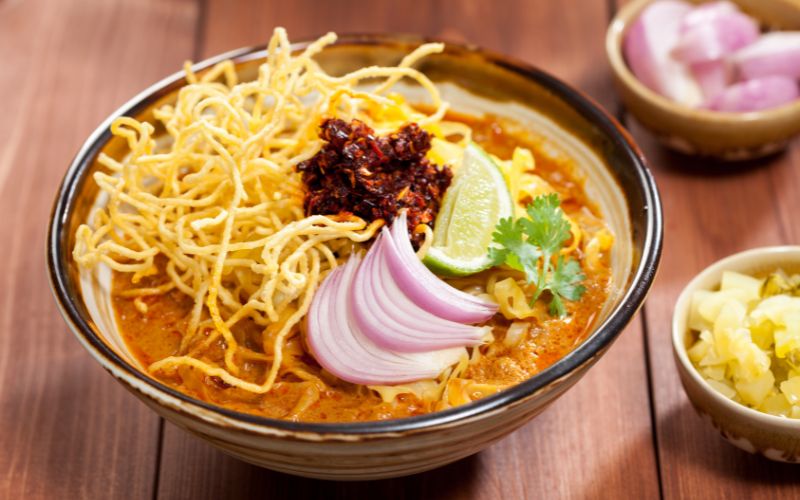
Khao Soi (Flat Rice Noodle)
Sai Oua (Lao Sausage)
Sai Oua, a beloved Lao sausage, is a culinary treasure famous for its bold and complex flavors. Crafted from finely ground pork, this delectable treat is infused with a harmonious blend of aromatic herbs and spices, including lemongrass, galangal, kaffir lime leaves, shallots, cilantro, chili, garlic, and sticky rice. The result is a sausage that bursts with flavor, offering a perfect balance of sweet, salty, and spicy notes.
Sai Oua is traditionally encased in a natural casing, allowing for a juicy and satisfying texture. Whether grilled, fried, or enjoyed fresh, this iconic Lao sausage is a must-try for food enthusiasts seeking an authentic taste of Southeast Asia.
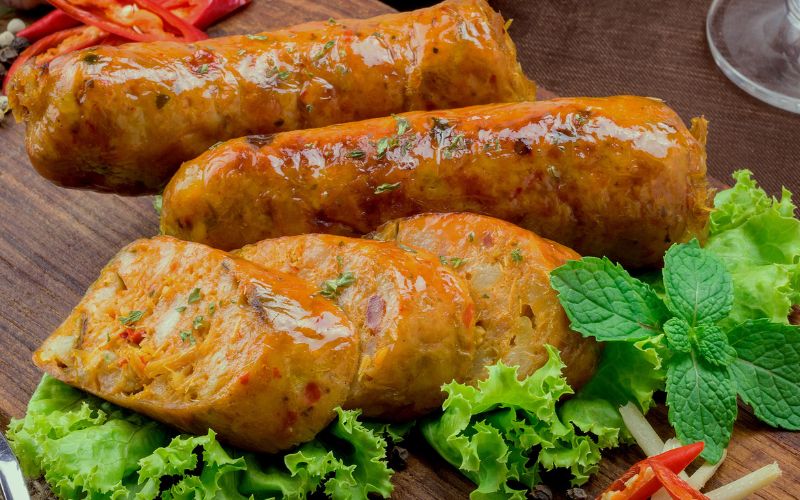
Sai Oua (Lao Sausage)
Khao Nom Krok (Laos Coconut Cakes)
Khao Nom Krok is a delightful Laotian sweet treat that offers a unique taste and texture. Often described as a coconut custard pancake, it is a popular street food enjoyed by locals and visitors alike. The dessert is prepared by pouring a batter made from rice flour, coconut milk, sugar, and a touch of salt into small, individual molds. The batter is then steamed until set, resulting in a soft and tender cake with a slightly crispy bottom. The sweetness of the coconut milk combined with the savory undertones of the rice flour, creates a harmonious flavor profile.
Khao Nom is traditionally served warm, often topped with refreshed coconut flakes for added texture and richness. This delectable dessert is a must-try for anyone exploring the culinary wonders of Laos.
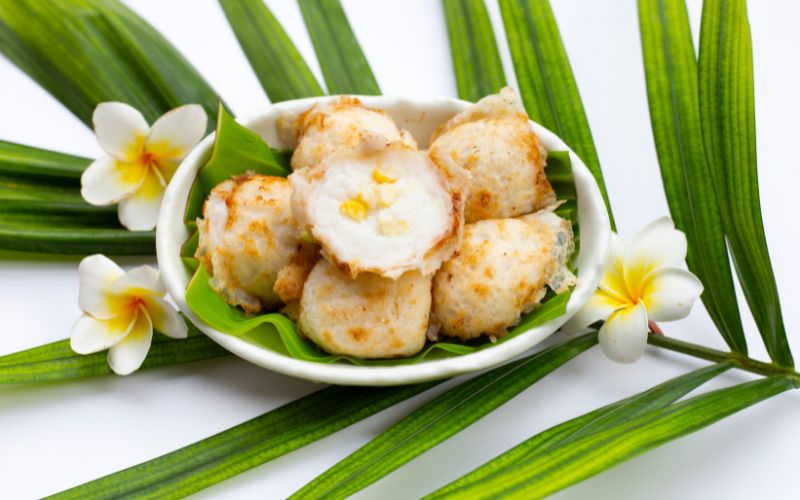
Khao Nom Krok (Laos Coconut Cake)
Khao Jee Sandwich (Baguette Sandwich)
Khao Jae Sandwich, a distinctive culinary creation from Laos, offers a delightful fusion of textures and flavors. This unique sandwich features a crispy exterior and a soft, savory interior. The bread, often made from sticky rice flour, is filled with a delectable combination of ingredients, including ground pork or chicken, chopped onions, and a medley of fresh herbs. The filling is typically seasoned with a blend of fish sauce, lime juice, and chili peppers, creating a harmonious balance of sweet, sour, and spicy flavors.
To enhance the taste, the sandwich is often accompanied by a dipping sauce made from chili peppers, lime juice, and fish sauce. Khao Jae Sandwich is a popular street food option in Laos, offering a satisfying and flavor snack for locals and visitors alike.
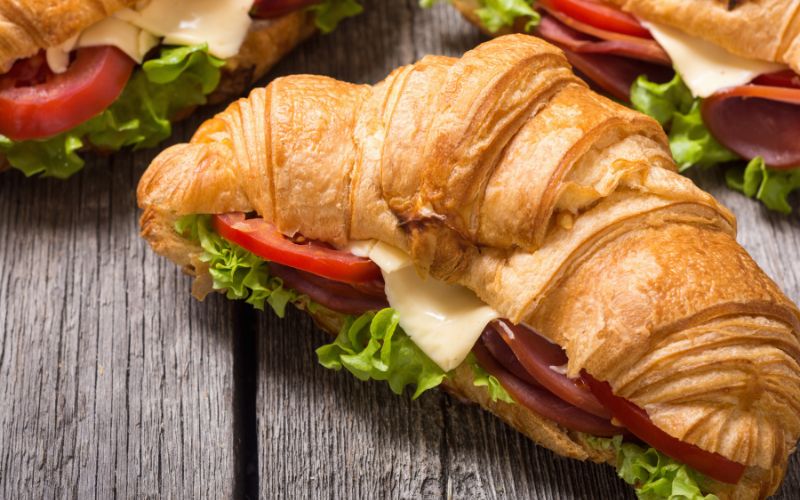
Khao Jee Sandwich (Baguette Sandwich)
Khao Poon (Rice Vermicelli Soup)
This is a flavorful and comforting noodle soup in Lao cuisine. This aromatic broth is typically made from a rich blend of spices, and coconut milk, and often includes fish or pork as a protein base. The star of the dish is the wide rice noodles, which soak up the complex flavors of the broth,
Khao Poon is often garnished with fresh herbs like cilantro and scallions, along with lime wedges for added zest. To enhance the taste experience, crispy noodles or shallots are sometimes added as a crunchy contrast. This hearty and satisfying soup is a true culinary delight that showcases the richness and complexity of Lao flavors.
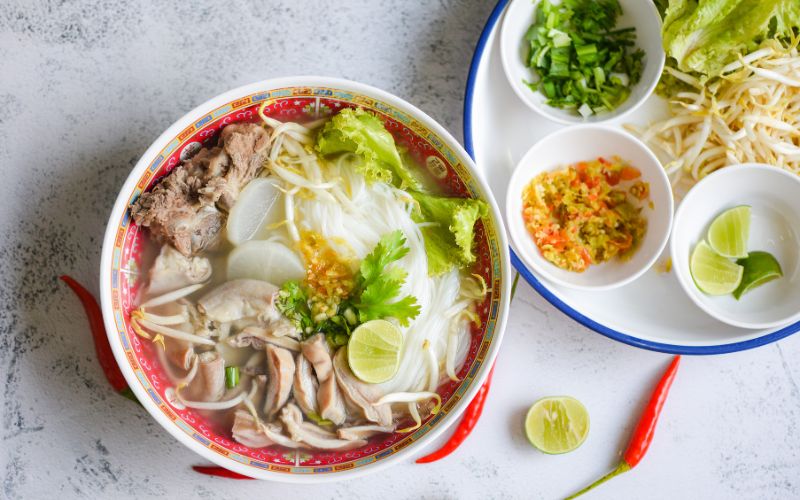
Khao Poon (Rice Vermicelli Soup)
Khao Piak Sen (Lao Chicken Noodle Soup)
Khao Piak Sen is a beloved Laotian noodle soup renowned for its delicate flavors and comforting warmth. This aromatic broth is typically made with a rich blend of chicken or pork bones, infused with galangal, lemongrass, and other flagrant herbs and spices.
The star of the dish is the thin rice noodles, which are cooked to perfection and served in a generous bowl of flavorful broth. To enhance the taste, various toppings are added, including sliced chicken or pork, crispy shallots, fresh herbs like cilantro and scallions, and a squeeze of lime. Khao Piak Sen is a quintessential Laotian breakfast or light lunch, offering a satisfying and nourishing experience.
Enjoying Khao Piak Sen for breakfast would be the perfect start for the day as it offers comforting warmth and flavorful broth.

Khao Piak Sen (Lao Chicken Soup)
Yaw Khao (Lao Spring Rolls)
Lao spring rolls, often referred to as Yaw Khao, are a popular and refreshing dish. There are two primary types which are fresh spring rolls and fried spring rolls.
Fresh spring rolls typically consist of a delicate rice paper wrapper filled with a colorful assortment of fresh vegetables, herbs, and protein, such as grilled pork or shrimp. They are often served with a sweet and tangy dipping sauce. On the other hand, fried spring rolls are crispy on the outside and filled with a savory mixture of ground meat, vegetables, and glass noodles. These crunchy delights are perfect as an appetizer or snack. Both types of Lao spring rolls offer a delightful balance of behaviors and textures, making them a beloved choice among locals and visitors.
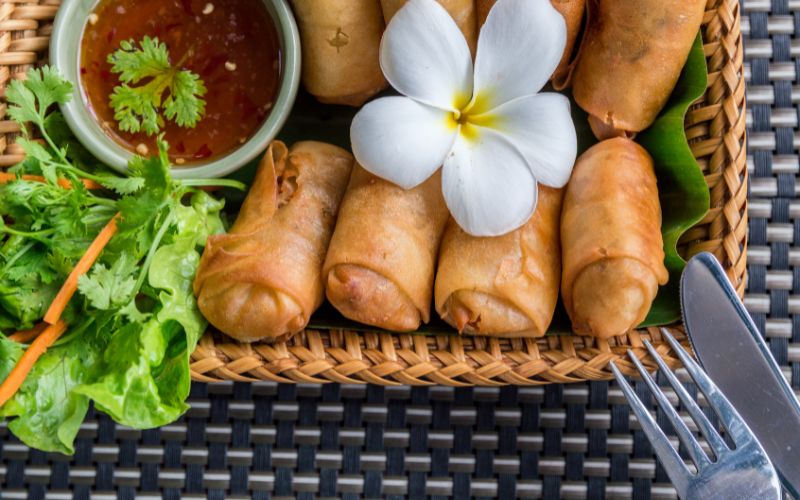
Yaw Khao (Lao Spring Rolls)
Seen Savanh (Lao Beef Jerky)
Seen Savanh is a delectable treat renowned for its unique flavor profile. Unlike its Western counterparts, Lao beef jerky boasts a sweet and savory taste, achieved through a careful balance of ingredients. The meat is typically marinated in a blend of sugar, salt, garlic, and other aromatic spices before being dried or smoked.
This process results in a chewy texture and a concentrated burst of flavor. Lao beef jerky is often enjoyed as a standalone snack or paired with sticky rice and a spicy dipping sauce. Whether you are exploring the vibrant Lao cuisine or seeking a satisfying and portable snack, this culinary delight is sure to impress.
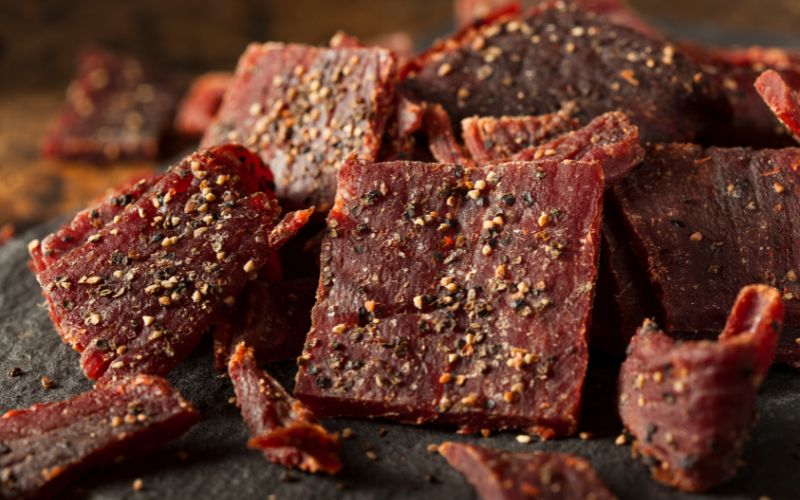
Seen Savanh (Lao Beef Jerky)
>>> Want to immerse yourself in Laos food heaven, book our Quintessential of Laos in 15 Days tour to satisfy your desire!
>>> For more information on Laos tourism, please read our Laos travel guide.
Best Places to Enjoy Laos Food
Vientiane Night Market
The Vientiane Night Market is a vibrant hotspot in Laos’ capital city, offering a bustling atmosphere where locals and tourists can indulge in authentic Lao street food. Situated along the Mekong River, the market comes alive in the evening with stalls serving everything from grilled meats and sticky rice to spicy papaya salad and fresh spring rolls. It’s a perfect place to experience the rich flavors of Lao cuisine in a lively setting, all while enjoying the cool evening breeze and the stunning riverside views that make this market a must-visit for food lovers.
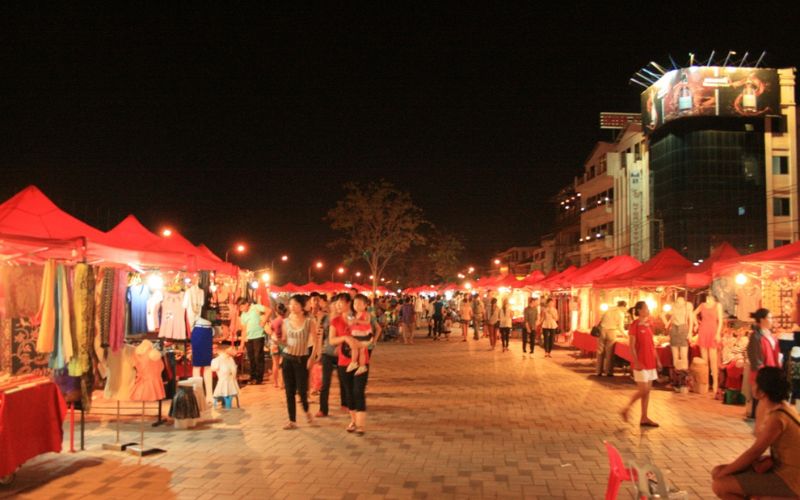
Vientiane Night Market
Luang Prabang Night Market
Luang Prabang, a UNESCO World Heritage city, is a culinary haven where traditional Lao cuisine meets colonial influences. The city’s Night Market is famous for its wide array of street food, including the iconic Khao Soi (coconut curry noodle soup) and Sai Oua (Lao sausage). For a more refined dining experience, explore the many colonial-style restaurants that offer a blend of Lao and French cuisine, often accompanied by stunning views of the Mekong River. Luang Prabang’s rich food scene is a testament to its cultural diversity, making it a top destination for any food enthusiast.
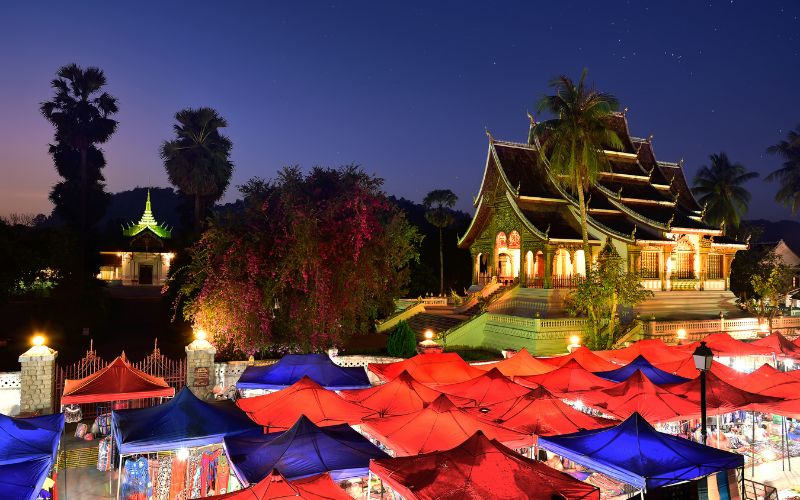
Luang Prabang Night Market
Vang Vieng
Nestled along the Nam Song River, Vang Vieng is known for its breathtaking landscapes and equally impressive culinary scene. The town’s riverside restaurants offer a unique dining experience where you can enjoy traditional Lao dishes like Laap (minced meat salad) and Tam Mak Hoong (papaya salad) while taking in the stunning views of limestone mountains and serene riverbanks. Vang Vieng’s relaxed atmosphere makes it an ideal spot to savor the flavors of Laos, whether you’re enjoying a simple meal at a street stall or dining in one of the town’s more upscale establishments.
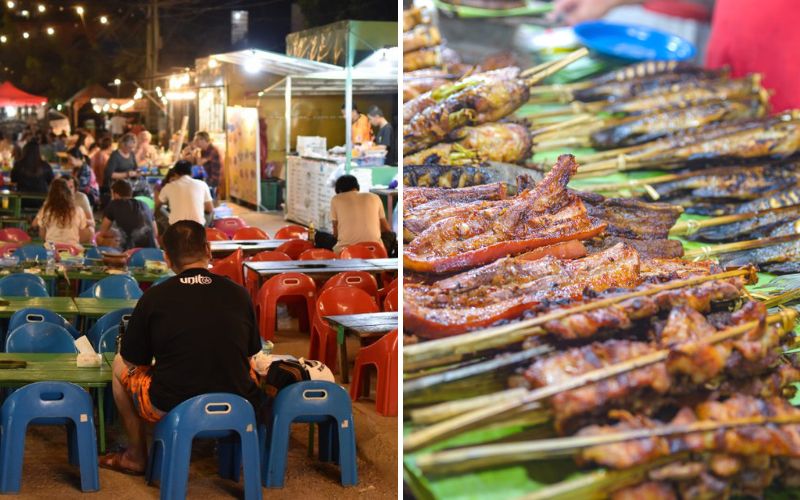
Vang Vieng Market
Pakbeng
Pakbeng is a small, charming town situated along the Mekong River, often visited by travelers cruising between Luang Prabang and Huay Xai. This quiet stopover is an excellent place to enjoy authentic Lao cuisine in a peaceful setting. The local eateries here serve traditional dishes like Mok Pa (steamed fish in banana leaves) and Or Lam (a hearty Lao stew) using fresh, local ingredients. With its serene riverside views and warm, welcoming atmosphere, Pakbeng offers a perfect taste of rural Lao life, making it a delightful culinary destination on your journey through Laos.

Pakbeng
Savannakhet
Savannakhet, the second-largest city in Laos, offers a unique culinary experience that reflects its diverse cultural influences. The city’s food scene is a blend of Lao, Thai, and Vietnamese cuisines, resulting in a rich tapestry of flavors. Street vendors and small local restaurants serve up delicious dishes like Pho (Vietnamese noodle soup), Khao Piak Sen (Lao rice noodle soup), and Nem Nuong (grilled pork sausage). Savannakhet’s relaxed pace, combined with its culinary diversity, makes it a hidden gem for food lovers looking to explore beyond the typical tourist trail in Laos.
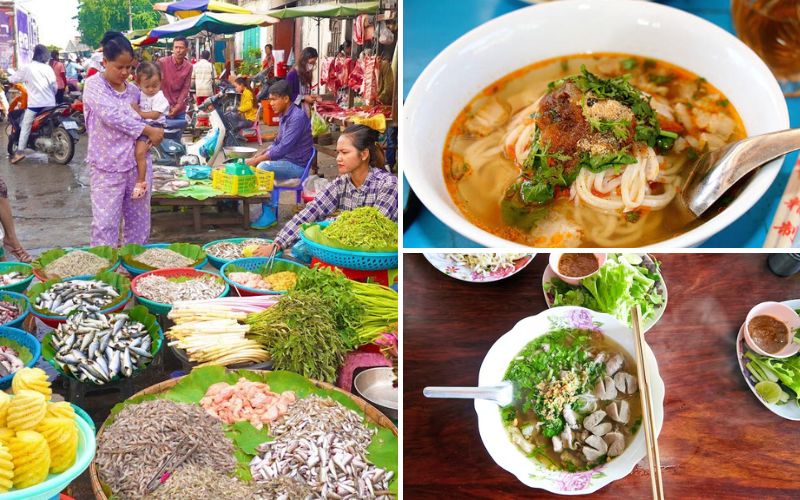
Savannakhet Market
It would undoubtedly be an unforgettable experience, especially for those who are food lovers to taste these delicious Lao cuisines. By tasting these dishes mentioned above, you can also have a more well-rounded perspective on Laos culture. So, how about contacting us and planning your trip around these wonderful places to immerse yourself in food heaven?
Read more:
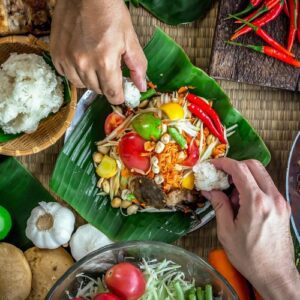
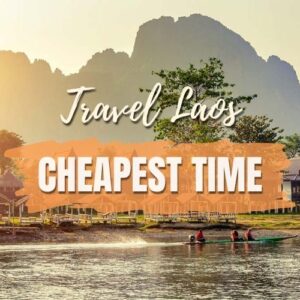

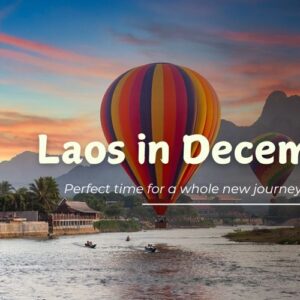
The photos look amazing. I’ve only been to Luang Prabang night market and tried a few snacks. Which night market in Laos would you say has the best food variety?
Dear Kenna,
Thank you so much for your kind words! The Luang Prabang night market is definitely a favorite for many travelers, especially with its relaxed atmosphere and local snacks. If you’re looking for the best variety of food in Laos, we’d recommend:
Vientiane Night Market – great for trying a mix of Lao street food and international bites, from grilled meats to noodle soups.
Luang Prabang Morning Market – less touristy, with authentic dishes like khao soi (Lao noodle soup) and fresh river fish dishes.
Savannakhet Night Market – smaller but very local, known for flavorful laap (minced meat salad), skewers, and sticky rice snacks.
Each market has its own charm, but if food variety is your priority, Vientiane usually offers the widest selection.
Best regards,
IDC Travel Team
Is Laotian food generally gluten-free friendly? I have some dietary restrictions.
Dear Vivian,
Thank you for your question! Laotian cuisine can be quite gluten-free friendly, as many traditional dishes are based on sticky rice, fresh vegetables, herbs, and grilled meats—naturally avoiding wheat. However, we recommend exercising caution with sauces like soy sauce or fermented condiments, which may contain gluten.
If you have specific dietary restrictions, we’d be happy to help customize your itinerary and meals accordingly. Just let us know your preferences, and we’ll work closely with local restaurants and guides to ensure a safe and enjoyable culinary experience throughout your trip.
Best regards,
IDC Travel Team